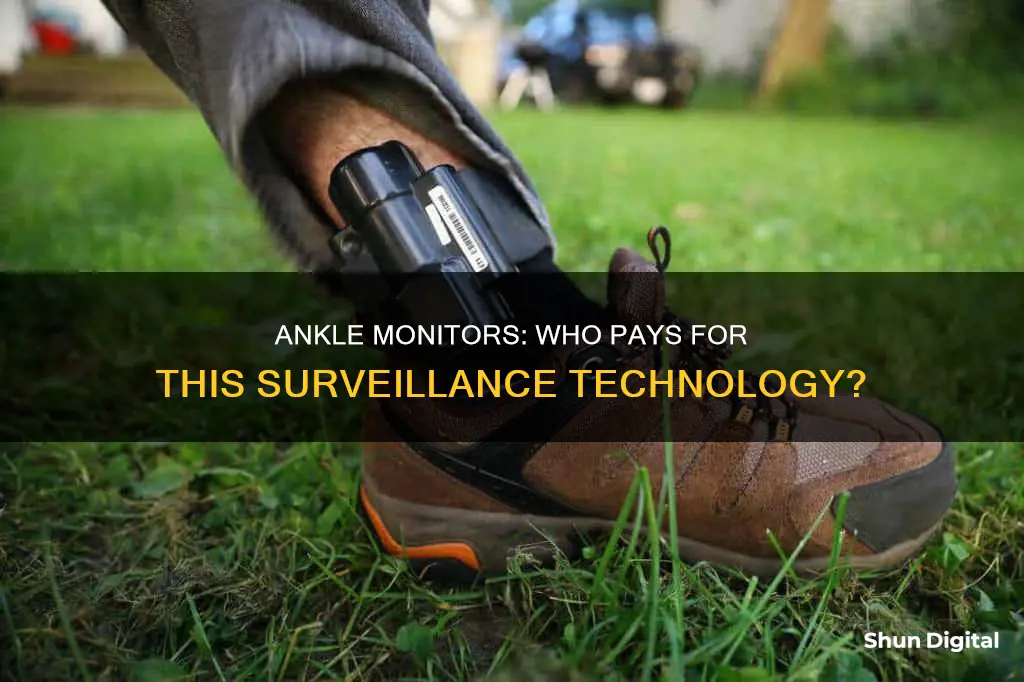
Ankle monitors are a form of surveillance that tracks the location of individuals who have been sentenced to restricted travel or activities. They are often used as an alternative to incarceration, with the goal of deterring repeat behaviour and reducing mass incarceration. However, the cost of these devices, which can range from $3 to $35 per day, has been a cause for concern as it can burden individuals and drive them into debt. While ankle monitors are intended to be a more humane alternative to jail, their high cost and intrusive nature have led to criticisms and calls for reform.
| Characteristics | Values |
|---|---|
| Purpose | To ensure the wearer stays within boundaries set by the court |
| Type of sentence | An alternative to pre-trial detention or as a condition of probation |
| Cost | Defendants are charged hundreds of dollars a month to wear the device |
| Installation cost | $50 |
| Daily cost | $3-$35 |
| Setup charges | $100 to $200 |
| Who wears them | People awaiting trial, serving probation and parole, and facing immigration proceedings |
| Use cases | Serious crimes, repeat offenders, domestic violence, DUI or DWI, immigration cases |
| Features | Waterproof, lightweight, GPS, radio frequency, alcohol detection |
What You'll Learn

Who pays for ankle monitors?
Ankle monitors are typically used as a form of surveillance to track, monitor, or limit an individual's physical movement or alcohol consumption. They are often employed as an alternative to incarceration, particularly in cases involving substance abuse issues, probation, parole, or immigration proceedings. While ankle monitors have been touted for their effectiveness in reducing recidivism and serving as a deterrent, their usage has sparked concerns about mass incarceration, stigmatization, and systemic inequities.
So, who pays for these ankle monitors? The answer varies depending on the jurisdiction and the specific circumstances of the case. In most states, individuals on electronic monitoring (EM) are required to bear the financial burden themselves. These fees can be daily, weekly, or monthly charges, in addition to initial setup costs. The expense can be significant, ranging from $3 to $35 per day, with setup fees ranging from $100 to $200. Such high costs can be burdensome for individuals and families, especially when compounded over time.
However, it's important to note that there is a lack of transparency and consistency in the fees imposed for EM across different states. While 43 states have statutes explicitly authorizing EM fees, the specific amounts and conditions vary. Some states authorize reasonable" fees, leaving it to the EM provider to set the price without adequate oversight. This lack of standardization results in varying financial obligations for individuals subject to EM across the country.
Additionally, it's worth mentioning that a few states, such as California and Rhode Island, have taken steps to prohibit or restrict the use of EM fees. In these states, the financial burden of EM may be shouldered by the state or local governments. However, these states are in the minority, and most individuals on EM are responsible for covering the costs themselves.
The financial implications of ankle monitors are a significant concern, and the high fees associated with them can create a cycle of debt and punishment that disproportionately affects certain communities.
Is My Messenger Being Monitored? Signs to Watch For
You may want to see also

How do ankle monitors work?
Ankle monitors, also known as ankle bracelets, ankle shackles, or tethers, are a form of electronic tagging used to monitor the movements of individuals. They are typically used on people who have been sentenced to restricted travel or activities, including those awaiting trial, serving probation and parole, or facing immigration proceedings.
Ankle monitors work by using GPS tracking systems or radio frequency technology to record the location of their wearers. This allows jurisdictions to limit how long a person can stay outside and where they can go. The monitors are typically waterproof and lightweight, and are worn around the lower leg.
In addition to tracking location, ankle monitors can also be used to ensure that a person is abiding by the terms of their sentence with regards to sobriety. A Secure Continuous Remote Alcohol Monitor (SCRAM) bracelet can detect alcohol in a person's sweat, alerting authorities if the person violates their release conditions by drinking.
The cost of wearing an ankle monitor can vary depending on the jurisdiction, ranging from $3 to $35 per day, with additional setup charges. In some cases, individuals sentenced to wear an ankle monitor may be required to pay for it themselves as part of their sentence.
While ankle monitors can provide an alternative to incarceration and help deter repeat behaviour, there are also concerns about their effectiveness and impact on individuals. Studies have shown that monitors may fail to meet their stated goals of ensuring court appearances, protecting public safety, and advancing rehabilitation. Additionally, the use of electronic monitoring has been criticised for exacerbating systemic inequities and contributing to mass incarceration.
Plasma Monitors: Large Screens, Commercial Availability
You may want to see also

Are ankle monitors effective?
Ankle monitors are an alternative to traditional imprisonment, allowing individuals to serve their sentences while remaining in the community. They are typically used for people on probation or parole, or those awaiting trial. They can also be used for individuals convicted of a crime but who are considered low-risk and not a danger to the community.
Ankle monitors are equipped with GPS technology to track an individual's movements and location. They can also be used to detect alcohol consumption through perspiration. This allows probation officers to verify that individuals are adhering to mobility restrictions and curfews.
Ankle monitors have been shown to be effective in reducing recidivism and enhancing community safety. In Washington State, a 2013 report found that 77% of individuals on SCRAM bracelets remained sober throughout the program. Additionally, the use of ankle monitors can be a less expensive alternative to incarceration, as individuals can maintain their jobs and support their families while serving their sentences.
However, there are some disadvantages to ankle monitors. They can be uncomfortable to wear and cause skin irritation. Individuals with ankle monitors are subject to strict rules and regulations, and any violation can result in additional penalties or imprisonment. The cost of ankle monitors can also be a burden, with fees ranging from $3 to $35 per day, in addition to initial setup charges.
In conclusion, ankle monitors can be an effective alternative to traditional imprisonment, but they should be used with discretion, considering the offender's risk of recidivism and the nature of the crime.
Monitoring Bandwidth Usage: Netgear Device Management
You may want to see also

Who might be required to wear an ankle monitor?
Ankle monitors are typically used for people who are awaiting trial, on probation, or are out on bail. They are also used for people serving parole, facing immigration proceedings, or those with substance abuse issues. In some cases, ankle monitors are used as an alternative to pre-trial detention or jail sentences.
Serious crimes, such as murder, sexual assault, or major drug offences, often result in the court requiring the defendant to wear an ankle monitor as a condition of bail or parole. Repeat offenders, or those who have violated bail or parole terms in the past, may also be required to wear one. Ankle monitors are also used in cases of domestic violence, ensuring that the offender maintains a required distance from the victim.
In the case of substance abuse, a Secure Continuous Remote Alcohol Monitor (SCRAM) bracelet can detect alcohol in a person's sweat, alerting authorities if the person violates the terms of their release by drinking.
Ankle monitors are also used in immigration cases, ensuring that individuals awaiting court dates do not leave a certain area.
Mixing Refresh Rates: Can You Connect a 60Hz and 144Hz Monitor?
You may want to see also

What are the alternatives to ankle monitors?
Ankle monitors are typically used for individuals who are on probation or parole, or for those who are awaiting trial. They are often used as an alternative to traditional imprisonment, allowing individuals to serve their sentences while remaining in the community.
Some alternatives to ankle monitors include:
- Court reminders and transportation assistance: These measures can help ensure that individuals comply with their court obligations without the need for constant electronic monitoring.
- Work release programs: In some cases, individuals may be allowed to leave prison or detention during the day to go to work, and then return to serve their sentence at night. This can help individuals maintain their employment and support their families while still serving their sentence.
- Diversion programs: Diversion sentences allow individuals to avoid jail time by participating in treatment programs or other alternative sentences. This can be especially useful for individuals who show clear signs of substance abuse issues, as prison can be detrimental to their recovery.
- GPS-enabled uniforms and backpacks: In Japan, a company has created GPS-enabled uniforms and backpacks for school children. This allows children to quickly summon a security agent to their location in case of an emergency.
- Electronic monitoring of vehicles: Public transport vehicles can be outfitted with electronic monitoring devices that communicate with GPS systems, allowing for accurate tracking of their location and providing passengers with real-time transit information.
- Curfews: In some cases, individuals may be subject to a curfew as an alternative to ankle monitoring. This allows them to continue living in the community while still being subject to certain restrictions on their movement.
Nutrisence Sugar Monitor: A Buyer's Guide
You may want to see also
Frequently asked questions
No, ankle monitors are not free. Private companies charge defendants hundreds of dollars a month to wear the surveillance devices. Fees to wear these monitors range from $3 to $35 a day, often in addition to initial setup charges, which can range from $100 to $200.
Ankle monitors are used for people awaiting trial, serving probation and parole, and facing immigration proceedings. They are also used for people who have been sentenced to restricted travel or activities, or who need to refrain from drinking alcohol.
Ankle monitors are used to track the movements of individuals who have been sentenced to restricted travel or activities. They can also be used to ensure that a person isn't violating the terms of their sentence with regards to sobriety.
Ankle monitors use GPS tracking systems to record the location of their wearers. They can also detect alcohol in a person's sweat, alerting authorities if the person violates the terms of their release by drinking.
Ankle monitors are promoted as a humane alternative to jail. They can help deter repeat behavior and reduce the cost of incarceration. However, they can also be expensive, invasive, and stigmatizing. Studies have shown that monitors fail to demonstrably meet their stated goals of ensuring court appearances, protecting public safety, and advancing rehabilitation.







